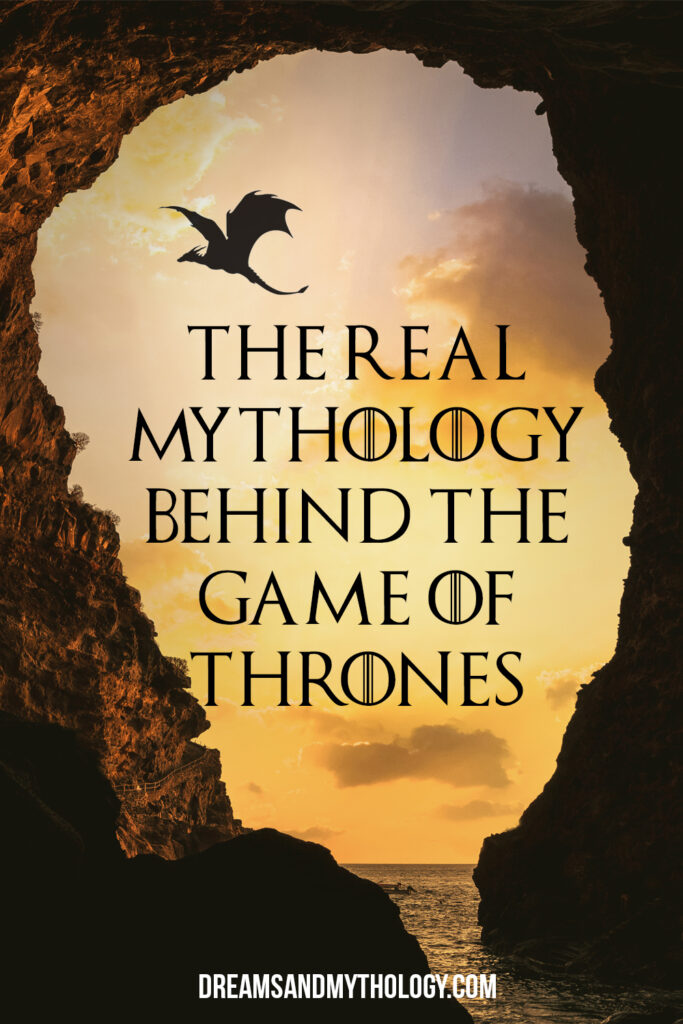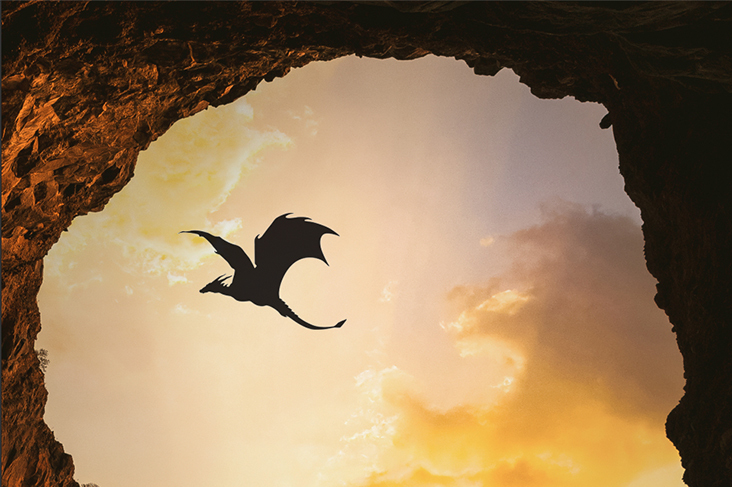Suppose you’ve been a regular reader of Dreams and Mythology. In that case, you already know that we don’t view mythology as old, fictional stories that belong in the past. No, we believe mythmaking is an art form that influences all mediums of storytelling.
From movies to modern mythopoeic sagas, we employ narratives and primordial archetypes used thousands of years ago.
And the Song of Fire and Ice isn’t an exception!
It weaves extreme realism in myths and heroic epics. George Martin looked at history through the prism of mythology. He retold parts of lost European folklore and history.
Like Homer, he borrowed from real events, battles, and characters, reconstructing a fantastical reiteration of them.
Not only that, he cleverly built on the premade structure of reality. Where Tolkien world-builds, Martin refines and expands.
Bringing Mythology to the 21st Century

I started reading the books a couple of years after GoT was released for television. I was determined to finish all of them before watching the first episode.
When I read the last chapter of “A Dance with Dragons,” I went on to download season one.
I had low expectations. How can they recreate what was in the books?
Yet, they somehow managed to properly capture the complexity and grey palette of the characters.
The mythology of Game of Thrones was depicted with the utmost respect, adapting to the modern medium without taking away from the story (up until season 6, at least).
But the plotline itself helped the producers immensely. See, while the author is talented, he drew inspiration from multiple mythological stories that were already nested deep into our psyche.
Let’s explore the real mythology behind The Game of Thrones.
War of the Roses
Do you know how the Iliad was inspired?
People believed that it was merely a fictional story, set in the Heroic Era where monsters and heroes roamed Greece.
Yet, in the late 19th century, archaeologists slowly unearthed the ruins of the fallen city. Some believe that there was a Trojan War and Homer simply dramatized it for his titular epic.
In the same manner, George R.R Martin retells the War of the Roses through his imagination.
The war for the throne of England shares similar characteristics with the war for the Iron Throne.
In 25 years, five different Kings from the Lancaster and York royal lineage ruled England. The conflict was so brutal that it wiped out all of the male heirs, leading to the domination of the Tudor family.
I wonder if the end of the series follows the same pattern.
Mad Kings
Aerys II Targaryen is perhaps the moral instigator of spreading discord and anarchy to the realm of Westeros.
Similarly, Henry VI of England, the only English heir to become King of France, suffered from schizophrenia and bouts of madness.
His adversaries exploited this. The same way the Mad Aerys Targaryen lost his throne due to the machinations of the Lannisters.
The Pantheon of the Game of Thrones
Gods and religion in ASOIAF are complicated. While they play a role in advancing the plot and imbuing the world with mythology, we don’t clearly understand how important they are.
Given that the author considers himself an agnostic, you’ll find much pushback against religious zealotry from major characters, most notably Tyrion Lannister. But Martin appreciates the influence faith has on people.
The Starks are a perfect example of devotees who fight for their beliefs even when the whole world changes course.
With that in mind, the political capital the advocates for these different religions possess puts them at the forefront of the mythological history of Westeros. It’s also interesting to note that the major religions borrow elements from our while also employing theological concepts.
The Old Gods
Similar to the Proto-Indo-European religions, this is nature’s religion borrowing heavily from Celtic and Norse traditions.
These Gods were worshipped by the First Men, who adopted the religion from the Children of the Forest upon their arrival.
But like Paganism, they were slowly eclipsed by the dominant religion of the South. Only the North and the Free Men beyond the Wall are worshipping the Old Gods. The same way Paganism remained the religion of the common folk in the country.
The Seven Gods
We can compare the faith of the Seven Gods with Christianity. Emerged in the South (the Mediterranean region) and made its way to the North.
While the name confuses people, we’re talking about a monotheistic religion; one God with multiple facets similar to the Holy Trinity.
The Red God
Relying heavily on dualism and a Manichean worldview, it resembles Zoroastrianism and Ahura Mazda.
R’hllor, the Lord of Light, seeks to bring light to the world and defeat his antagonist, The Great Other.
What’s interesting here is that one of the main practices of Zoroastrianism includes fire which represents the source of light!
The Red God is worshipped prominently in Essos.
There are many more religions inside and outside of Westeros, in line with the multi-religious reality of our world.
Biblical Tropes
Even though George Martin is an atheist/agnostic, he was raised as a catholic with a keen interest in religion and spirituality in general.
This jumps out of the pages of GoT, with many biblical references inserted in the mythology.
The Massacre of the Innocent
When King Baratheon dies, the question of who gets to sit on the Iron Throne has readily answered; his son!
But rumors of a bastard son with a legitimate claim to the throne throws King Joffrey into a fit of rage and madness. He orders the killing of all of Robert Baratheon’s potential offspring, creating a bloodbath in King’s Landing.
The killing spree resembles the Herod’s Massacre of the Innocent, depicted in Mathew’s Gospel. The King of Judea, upon hearing of the arrival of the Magi heralding the coming of the “son of God “, fills with jealousy.
The solution is simple: kill all children younger than two years old.
Even though this is part of folklore or rumors triggered by the strict personality of Herod, the alleged victims of his madness are considered the first Christian Martyrs.
Martyr means “witness.” In the case of King Joffrey, the adolescent victims were indeed the first to witness the true nature of their King…
Jon Snow and Jesus Christ
Even though the Song of Fire and Ice mythopoeic saga doesn’t have a clear protagonist – rather many perspectives that create a mosaic – if we were to consider who’s embodying the “classical” archetype of the Hero, then Jon Snow is probably the one.
He possesses all of these qualities that make a simple man a hero. Humble, yet courageous. Strong, yet fair. Righteous, yet punished.
His narrative is parallel to Jesus’ life. Both don’t necessarily belong in their respective companies, but they never scoff at lesser men. Instead, they try to elevate them, make them greater than what they are. For that reason, they’re ostracized.
- Jon Snow has royal blood but ends up in the presence of criminals
- Jesus Christ is the Son of God but prefers to spread the message to simple working men and women
- Jon Snow feeds the Wildlings from the limited food supply of the Night Watch
- Jesus Christ feeds the unfortunate with a few loaves of bread and fish
- Jon Snow died and was resurrected to fulfill his purpose
- Jesus Christ died for the Sin of Men and was resurrected after three days
In the end, they were betrayed by the people who they considered closest to them.
Moses and Daenerys Targaryen
Another Biblical reference is that of Moses leading the Israelites through the desert and to the promised land.
Daenerys follows the same trajectory.
She escaped death when she was still a child. Similarly, Moses escaped the wrath of the Pharaoh. In a basket, he sailed across the Nile while the Mother of Dragons crossed the Narrow Sea.
Born to be leaders, they rallied their people and guided them through danger and barren land, freeing them from slavery.
Whether Daenerys will manage to set foot in Westeros is still the big question. Judging by the story of Moses, who managed to only look at the promised land, there might be a big plot twist awaiting us.
Mythical Creatures and Magic in Game of Thrones
One of the things that make Martin’s mythopoeic unique is how he employs fantasy. Instead of drowning the books with complex magical systems or massive world-building, he only uses these tropes when necessary to progress the plot.
This is perhaps what creates a sense of depth and significance when we encounter them.
Dragons
One of the bigger arcs of the books is the birth and taming of dragons. In the beginning, all we hear are legends of their destructive power. And we see their empty carcasses hanging from the hall of the Iron Throne, reminding everyone of their magnificence.
Eventually, the Mother of Dragons, Daenerys Targaryen, manages to hatch an egg and unleash their power in the world once again.
But instead of being these invincible, undefeated creatures, they’re of flesh and bones. Powerful, yet vulnerable to steel and arrow.
Wargs
In Norse mythology, wargs are large wolves. The name is mostly used to describe Fenrir, Skoll, and Hati, who chase the sun and the moon.
Tolkien took inspiration and created a new breed of a large, particularly evil, wolf for his Legendarium.
In the Game of Thrones mythopoeic saga, wargs are skinchangers, controlling animals and seeing through their eyes.
Ravens
Resembling the carrier pigeon, in Game of Thrones, ravens are smart creatures that can carry messages from castle to castle.
Like in real life, they can imitate human speech. The white raven is a subspecies that’s even more intelligent and can speak “True Tongue,” the language of the Children of the Forest.
The White Walkers
The main antagonist, the Others signify an apocalyptic event. Their coming translates to the end of the world in a way.
They’re similar to the Frost Giants in Norse mythology, but they possess eerie, ghostly figures.
Magic in Game of Thrones
Magic is considered one of the highest mysteries in Westeros. If it existed, it’s now gone outside of religious practices. Even in places that it’s still used, like Essos, its power is often questioned.
But as the plot progresses and we’re moving East, we find abundant magic, which becomes stronger by the day in the presence of Dragons.
Martin doesn’t opt-in for over-the-top representations. He intentionally mystifies the practice to create a sense of hidden power.
Winter is Coming…
George R.R. Martin’s ability to syncretize history with fantasy is unmatched. A devoted student of ancient mythologies, he understood that fictional stories enable the mythmaker to express his perspective about humanity.
It’s one of the reasons his audience didn’t always enjoy fantasy fiction but found his work intriguing.
As I’m writing this, we’re still awaiting the final books of his epic mythopoeic saga. The coming of winter is near, though.
